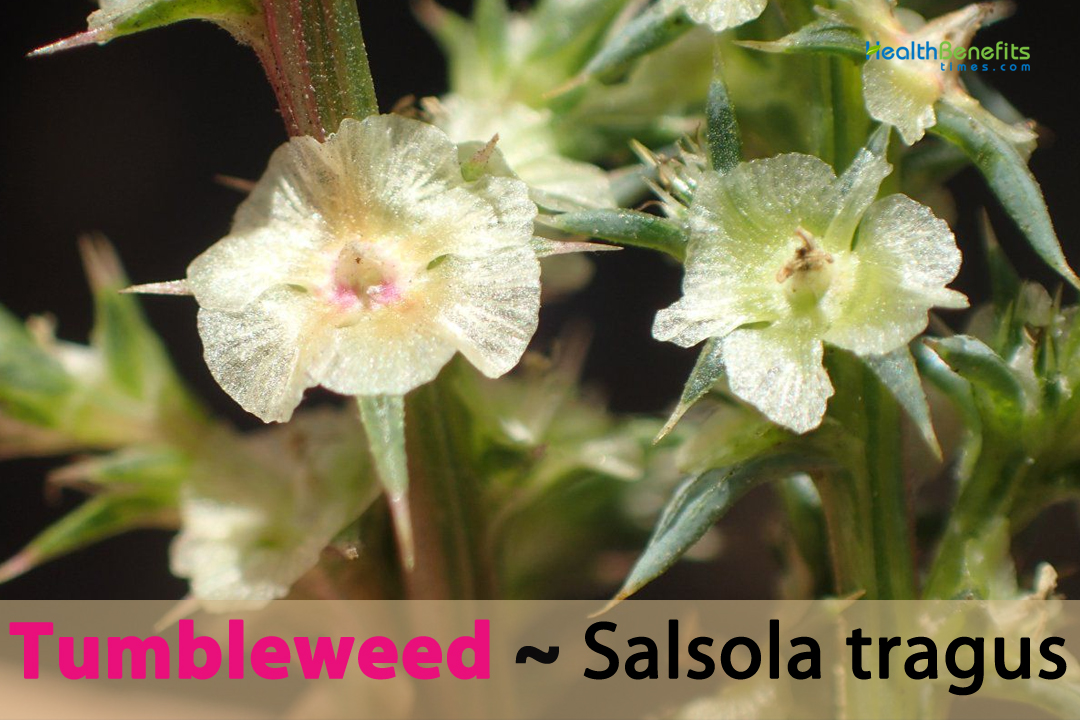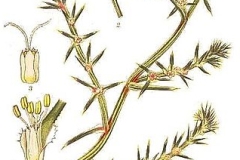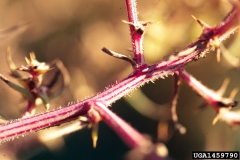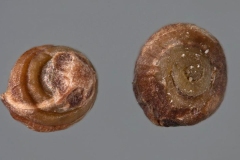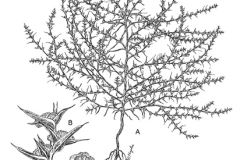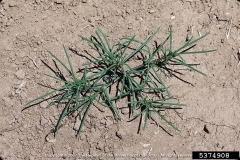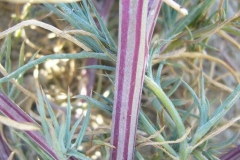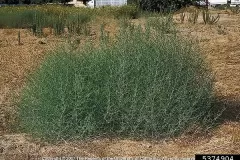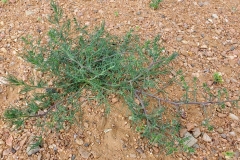| Tumbleweed Quick Facts | |
|---|---|
| Name: | Tumbleweed |
| Scientific Name: | Salsola tragus |
| Origin | Southeastern Europe to Central Asia (probably also partly in northern Africa |
| Colors | Initially green turning to pale yellow or tan, and eventually to a light brown or straw-like color |
| Shapes | Small round capsules about 0.19-0.31 in. (4.8-7.9 mm) in diameter |
| Major nutrients | • Protein • Fiber • Minerals • Phytonutrients |
| Health benefits | Skin Irritations, Digestive complaints, Diuretic Properties and Mild Laxative |
| Name | Tumbleweed |
|---|---|
| Scientific Name | Salsola tragus |
| Native | Southeastern Europe to Central Asia (probably also partly in northern Africa). It has become naturalized in many regions worldwide, including North America. It is often associated with the American West |
| Common Names | Russian thistle, Tumble-top, Salsify tumbleweed, Wandering weed, Cyclone weed, Tumble thistle, Salsola weed, Walking weed, Sand sagebrush, Prickly tumbleweed, Windwitch, Bushy Russian thistle, Wind-blown weed, Rolling weed, Barren brome, Wild tumbleweed, Salsola roller, Prickly Russian thistle, Tumble grass, Salsola sagebrush, Bushy sandbur, Tumble-brush, Salsola, Tumble-grass, Salsify |
| Name in Other Languages | Arabic: Ashbah at-Tadharraj (عشبة التدحرج), Eshbat al-Tamarrud (عشبة التمرد), Al-Hasha’ish al-Jamihah (الحشائش الجامحة) Assamese: Tambalweed (টাম্বলৱীড) Bengali: Ṭāmbal’ō’ida (টাম্বলওইড), Kudume patā (কুদুমে পাতা), Tambalweed (টাম্বলউইড) Chinese: Gǔn cǎo (滚草), Piāo cǎo (飘草), Ci sha peng (刺沙蓬) Croatian: Grmčica Czech: Travouš květonosný, slanobýl obecný Danish: Rullende plante Dutch: Rollende plant, Sail grass, Zacht loogkruid English: Russian thistle, Tumble-top, Salsify tumbleweed, Wandering weed, Cyclone weed, Tumble thistle, Prickly Russian Thistle, Russian Tumbleweed, Russian-Cactus, Spineless Saltwort, Tumbleweed Finnish: Pyörivä kasvi, Kelopallo French: Herbe roulante, Soude roulante, Soude épineuse, soude bouc, soude roulante German: Rollkraut, Kali-Salzkraut, Ruthenisches Salzkraut, Ukraine-Salzkraut, Glattes Salzkraut Greek: Kylióchorto (Κυλιόχορτο) Gujarati: Tambalweed (ટંબલવીડ) Hebrew: Tzimach ha-Galgal (צמח הגלגל) Hindi: Goli ghaas (गोली घास), Ṭambalvīḍ (टम्बलवीड), (Chalāṅgī ghās (छलांगी घास), टम्बलवीड (Tambalweed) Hungarian: Göröngyös gyom Icelandic: Rolla gras, þornurt Italian: Erba rotolante Japanese: Korogaru zassō (転がる雑草), Tanburuwīdo (タンブルウィード), Korogari kusa (転がり草), Hari hijikii (ハリヒジキ) Kannada: Tambul Veed (ಟಂಬುಲ್ ವೀಡ್), Tambul Akki (ತಂಬುಲ್ ಅಕ್ಕಿ) Kashmiri: Tambalweed (ٹمبلویڈ) Konkani: Tambalweed (टंबलवीड) Korean: Guleuneun japcho (구르는 잡초) Lithuanian: Vijoklinis žolynas Malay: Rumput berguling Malayalam: Tambalweed (ടംബൽവീഡ്), Thumppal Poo (തുംപൾ പൂ) Maithili: Tambalweed (टम्बलवीड) Manipuri: Tambalweed (টাম্বলউইড) Maori: Rārāhu Marathi: Tambalweed (टंबलवीड) Nepali: Tambalweed (टम्बलवीड) Norwegian: Rullende plante, Rullende gress Odia: Tambalweed (ଟମ୍ବଲ୍ୱିଡ) Polish: Rozwijak, Kulawiec Portuguese: Erva rolante Punjabi: Tambalweed (ਟੰਬਲਵੀਡ) Romanian: Larbă baltă Russian: Buryan (Бурьян), Barashek (Барашек), Solianka tragus (Солянка трагус), Solyanka yuzhnaya (Солянка южная), Solianka russkaia (Солянка русская), solyanka sornaya (солянка сорная), solyanka tragus (солянка трагус) Sanskrit: Tumbulaka (तुम्बुलक) Santali: Tambul Pod (ᱴᱟᱫᱪᱤᱴᱯᱤ) Serbian: Čičak trava Sindhi: Tambalweed (ٽمبلويڊ) Slovak: Slanobyľ Spanish: Planta rodadora, Rodadora Swahili: Nyasi ya mzunguko, Nyasi ya Tumbleweed, Mchepuko Swedish: Rullande växt, Rysk sodaört Tagalog: Gulong damo Tamil: Ṭampilvīṭ (டம்பிள்வீட்), Paḻaṅkuṭal (பழங்குடல்), Thumpl Veed (தும்பிள் வீட்) Telugu: Tambul Veed (టంబుల్ వీడ్) Thai: Yā wạy dīyw (หญ้าวัยเดียว) Turkish: Yuvarlan ot, Rüzgar Gülü, Rüzgar Topu, kum döngelesi Ukrainian: Polyn (Полин), Baranyi pushok (Бараний пушок), kuray chiplyankovyy (курай чіплянковий) Urdu: Tambalweed (ٹمبلوید), Jághun, Kalbahi, Soreh Vietnamese: Cỏ lăn |
| Plant Growth Habit | Large and bushy noxious annual broadleaf plant |
| Growing Climates | Open, sunny areas, sandy shores, cultivated fields, waste places, roadside, meadows, fields, semi-desert areas, deserts, fencerows, irrigated croplands, disturbed or overgrazed sites and other disturbed open areas |
| Soil | Grow in a lot of different types of soil, but it likes areas that drain well |
| Plant Size | 2 to 3 feet (0.6 to 0.9 meters) |
| Root | Taproot that can grow over 6 ft. (1.8 m) deep with extensive lateral roots over 5 ft. (1.5 m) long |
| Stem | Stems are opposite and many branched, often with red to purple longitudinal striations |
| Bark | No bark is present |
| Leaf | Small, narrow, alternate, semi-succulent to succulent, and gray-green in color. They are about 0.6-2 in (1.5-5 cm) long and 0.01-0.04 in (0.3-1 mm) thick |
| Flowering season | May to June |
| Flower | Small, inconspicuous flowers that lack showy petals. These flowers are often greenish-white in color |
| Fruit Shape & Size | Small round capsules about 0.19-0.31 in. (4.8-7.9 mm) in diameter having papery or membranous texture |
| Fruit Color | Initially green turning to pale yellow or tan, and eventually to a light brown or straw-like color |
| Seed | Small and typically have a spherical or oval shape measuring only a few millimeters in diameter |
| Flavor/Aroma | Odorless or mildly fragrant plant |
| Plant Parts Used | Whole plant |
| Propagation | By seed |
| Lifespan | Single growing season |
| Season | August to September |
| Major Nutrition |
|
| Health benefits |
|
Plant Description
Tumble weed is a big, bushy, noxious annual broadleaf plant that grows to be about 2 to 3 feet (0.6 to 0.9 meters) across when it’s fully grown. This plant grows in sandy shores, opened, sunny areas, wastelands, along the side of the road, in meadows, fields, semi-desert areas, deserts, fencerows, flooded croplands, overgrazed or disturbed areas, and other open, rough places. The plant can grow in a range of soils, but it likes soils that drain well. Most of the time, it lives in sandy or gravelly soils that drain water fast. It is easy for tumbleweed to survive in dry conditions. It can live in dry places with little water because its small, gray-green leaves help keep water from evaporating.
It lives in most areas across the United States and is found in many places. It does very well in dry and semi-dry environments. For example, you can find it in Salt Desert Scrub and Alpine environments where things have been moved around. People work to stop the spread of tumbleweed in places where it is seen as an unwanted species. This could mean using tools to get rid of them, using herbicides, or bringing in native predators. Even though tumbleweed is known as a bothersome plant, it can be a home for some animals. Small animals, like birds and mice, may use the dried stems as a place to hide or build a nest.
Appropriate growing environment for tumbleweed
Tumbleweed is adapted to thrive in specific environmental conditions. Here are the key factors that constitute an appropriate growing environment for tumbleweed:
- Arid and Semi-Arid Regions: Tumbleweed grows well in dry and semi-dry places. It usually lives in dry, desert-like places that don’t get much rain each year. In these areas, water is usually hard to come by, so tumbleweed has changed to save water.
- Full Sunlight: Tumbleweed grows best in open, sunny places where it gets full sun. It usually lives in open fields, along roadsides, and other places that get a lot of sun.
- Well-Drained Soil: Tumbleweed can grow in a lot of different types of soil, but it likes areas that drain well. Most of the time, it lives in sandy or gravelly soils that drain water fast. It is also known that the plant can grow in salty soils, which are common in some dry areas.
- Dry and Windy Conditions: It is common for tumbleweed to roll, which is easier to do when it is dry and windy. The plant’s structure has changed over time to allow it to tumble and spread in the wind, which helps spread its seeds. Because of this, a fairly windy place can help it grow and spread its seeds.
- Disturbed Areas: Tumbleweed usually does best in places that have been moved or changed by people. It can settle down in places that people have disturbed, like building sites, farmland, and the sides of roads.
- Annual Growth Cycle: If you grow tumbleweed every year, it will finish its life cycle in one growth season. It starts from seeds, grows, makes more seeds, and then dies back when it gets too dry. Because of this adaptation, it can survive in dry places during short times of good weather.
- Naturalized Range: The tumbleweed plant is native to some parts of Eurasia, but it has spread to many other places, including North America, where it is often linked with the American West. It has spread to new places because it is flexible and can do well in harsh conditions.
Roots
Tumbleweed plants have a taproot system, which means they have one main root that is thick, goes deep into the ground, and grows vertically. This plant’s main structure support is its taproot, which also lets it get water and nutrients from deeper in the soil. Even though tumbleweed plants have a taproot, it’s not very deep compared to the roots of some other plants. Most of the time, the taproot only goes a few feet into the ground. This shallowness makes it easy to pull the plant out of the ground and helps it break away from its roots, which lets it fall over in the wind. The taproot system of tumbleweed helps it survive in dry and semi-dry places. It helps the plant get to water deeper underground, which increases its chances of living in places where water is scarce.
Stem
Most tumbleweeds have branches that are hollow and dry and brittle. Because they are hollow, they float and are easy for the wind to carry. The stem is often split into sections that let it bend and flex as it moves on the ground. This gives the tumbleweed the ability to get around objects and keep going on its way. Tumbleweeds spread seeds with their roots. When the plant dries out and the stem separates from the roots, it falls apart and floats away in the wind. It spreads seeds along the way, which helps the plant grow in new places.
Bark
The roots of tumbleweeds are herbaceous and not woody. And this means that the skin on them is not bark in the usual sense, like on a tree. Instead, when they are young, their stems are green and bendy. As they get older and dry out, the stems become hard and crack. A grown tumbleweed stem’s outside is often rough and full of small spines or prickles. These structures can help protect the plant from plants that eat other plants, and they may also help keep the plant wet in dry deserts where it lives.
As the tumbleweed plant ages and dries out, the roots get stiffer and more easily broken. The stem eventually falls apart, mostly at the base. This lets the whole plant break free from its roots and turn into the famous moving tumbleweed that is often found in dry areas.
Leaves
In general, tumbleweed leaves are small and narrow. Because the plant often grows in dry, desert-like conditions, these parts are designed to keep as much water as possible from evaporating. The leaves’ smaller surface area helps them hold on to water. The leaves are mostly a gray-green color. This color is an adaptation that helps them reflect sunshine and keep heat from absorbing it, which keeps them from losing too much water through evaporation. The leaves of tumbleweed often have fine hairs on them that do more than one thing. This hairs help keep water in the leaf by creating an insulating shield of still air around the leaf’s surface. They also help keep plants from losing too much water and protect against animals.
Flowers
The flowers of tumbleweed are usually arranged in a spike or spikelet, which is a flowering structure. The flowers are small and not very showy on their own. Pollinators like bees and butterflies are generally not drawn to them because they don’t have bright colors or big petals. Flowers usually have five parts that look like petals and can be white or pale green. These structures that look like petals are usually very small and hard to see. There are five sepals, which are usually green and may look like small leaves that surround the flowers. The reproductive parts of the tumbleweed flower are in the middle. These are the petals and pistil. The male reproductive parts are called stamens. They are made up of thin filaments and anthers, which are where pollen is made. The female reproductive part is called the pistil, and it usually has an ovary, a stigma, and a style.
Fruit
Tumbleweed has a fruit that is a special organ called a capsule. This package is usually small and round, and it feels like paper or membrane. It’s made up of several parts, usually five, that are joined at the bottom but split apart at the top. There are several seed compartments inside the capsule, and each one matches one of the pieces. The tumbleweed plant’s mature seeds are stored in these sections.
Seeds
There are small tumbleweed seeds that look like spheres or ovals. They are pretty small; the width is only a few millimeters. The seed coat, also written as seed husk, is the outside layer of a seed. It’s thin, like paper, and sometimes see-through. The baby inside the seed is protected by the seed coat, which also helps keep the seed from drying out. There is a tiny embryo inside the seed coat. This is the immature plant that will grow into a new tumbleweed if the circumstances are right. The embryo has all the important parts that are needed for development and the first stages of growth.
Health benefits of Tumble weed
Russian thistle or tumbleweed, is not typically recognized for significant traditional medicinal uses in human health. Instead, it is primarily known as a weed and has limited documented therapeutic applications. However, in some very specific and localized traditional practices, tumbleweed has been used for minor medicinal purposes:
1. Skin Irritations
In some ancient herbal practices, tumbleweed extracts or infusions were put on the skin to help with small skin problems like rashes or itching. This use, on the other hand, is not well-documented or generally known.
2. Folk Remedies
In some parts of the world, people have used its extracts or infusions as a traditional medicine for light digestive problems like indigestion or upset stomach. But there isn’t a lot of information about these uses, and scientists haven’t checked to see if they are safe or effective.
3. Diuretic Properties
Tumbleweed has been used as a diuretic in some traditional plant practices in some areas. This means that it has been eaten or applied to the skin to make people urinate more. This use was often linked to trying to get rid of mild edema, or water buildup. But there isn’t a lot of information or agreement on these uses, and scientists haven’t proven that they are safe or effective.
4. Mild Laxative
In some cases, tumbleweed may have been used as a weak laxative in traditional folk medicine to help people who were having trouble going to the bathroom. These kinds of uses are not common and are not backed up by science.
Different uses of Tumbleweed
Tumbleweed has limited direct human uses but plays several roles in ecosystems and has some cultural significance. Here are different uses and roles of tumbleweed:
- Seed Dispersal: Plants that grow tumbleweed can break off from their roots, roll in the wind, and spread their seeds over a large area. This way of spreading helps the plant’s young find new places to grow.
- Erosion Control: Tumbleweed can sometimes help stop soil erosion by keeping sand dunes stable and stopping water and wind damage. In dry or mostly dry areas, they can be natural walls.
- Wildlife Habitat: Tumbleweed gives animals a place to live and food to eat. Small creatures and birds may use tumbleweed as a place to hide, and some animals eat the seeds.
- Cultural Symbolism: People often think of deserts and cowboy movies when they see tumbleweed, which has become a sign of the American West. It is used in pop culture to show a feeling of being alone and empty.
- Crafts and Decor: In places where it grows naturally, tumbleweed is sometimes used in crafts and as a rural decoration. People can make wreaths, gifts, and other pretty things out of it.
- Fodder in Limited Cases: Tumbleweed has been used as emergency feed for animals in very dry areas where other plants are hard to come by. This isn’t usually done, though, and you should be careful because it could be harmful.
- Educational Tool: Students and the public can learn about how plants change, how seeds spread, and ecology by using tumbleweed as an example. It lets you learn by doing, so you can see how plants connect with their surroundings.
- Firebreaks: Tumbleweed can be piled up in certain ways or used to make firebreaks in places where wildfires are likely to happen. This can help keep homes safe and slow the spread of flames.
- Composting Material: Even though it’s not common, tumbleweed can be added to waste piles to “brown” them and add carbon. Because it is dry and fibrous, it can help keep the carbon-to-nitrogen ratio in composting in check, which speeds up the breakdown process.
- Mulch: When you grow or landscape, you can cover the ground with tumbleweed as mulch. It can add organic matter to the soil and help it hold on to water as it breaks down.
- Artistic and Decorative Uses: Tumbleweed can be used as a unique and artsy part of outdoor decor and landscaping. You can paint it, put lights on it, or use it in other creative ways to make outdoor areas better.
- Symbolism in Literature and Art: In writing, poetry, and art, tumbleweed has been used as a metaphor for change, impermanence, and the passing of time. People often see its rolling shape as a metaphor for the path of life.
- Bioengineering Research: Researchers have looked into how the rolling motion of tumbleweeds could be used in bioengineering and robots. Researchers have used its process as a model for making robots that can spread seeds on their own.
Side effects of tumbleweed
Tumbleweed, specifically referring to plants like Salsola tragus that break away from their roots, tumble in the wind, and disperse seeds, is not typically associated with direct side effects in humans because it is not commonly consumed as food or used for medicinal purposes. However, there are some considerations and potential side effects to be aware of:
- Toxicity: Some types of tumbleweed have chemicals in them that are poisonous to both people and animals if they are eaten. If you eat toxic plants, you could get a lot of different health problems, like stomach problems, sickness, vomiting, and in the worst cases, poisoning. People should not eat tumbleweed and should be careful when it is around places where animals graze.
- Allergies: Some people may get allergies or skin irritations when they come into contact with tumbleweed or its pollen. For people who are sensitive, allergic responses can include rashes, itching, and breathing problems.
- Invasive Behavior: In some places, tumbleweed can spread quickly and kill off natural plants. Because it can spread so quickly, it can mess up local environments, lower biodiversity, and hurt farmland.
- Fire Hazard: When it’s dry, tumbleweed is very easy to set on fire. Gatherings of tumbleweed can be a fire risk in dry, arid areas, and they can help flames spread quickly.
- Mechanical Damage: Because tumbleweed rolls around, it can get caught in machines, fences, and other structures, which can damage them or make them less useful.
Management
1. Biological
Even though biological control agents have been found, there aren’t any major ways to get rid of Russian thistle. An Eriophyid mite and two fungal diseases are being worked on as bio-control agents right now.
2. Mechanical
For small amounts, pulling them out by hand works well, but mowing isn’t a good idea because it could spread the seeds. While tilling helps keep bigger plants and seedlings in check, it also causes more commotion, which could help prickly Russian thistle germinate and grow.
3. Prescribed Fire
Because prickly Russian thistle is so easily set on fire, controlled fire is not a good option. This could make wildfires more likely, especially since tumbleweeds can move around.
4. Grazing
Before it can reproduce, prickly Russian thistle is thought to be a good source of food for animals. If grazing happens before the blooming stage, it could change how many seeds are made. However, animals might get sick if they eat too much Russian thistle because it contains oxalates, as has been seen in sheep.
5. Chemical
From late winter to early spring, preemergence pesticide treatments work well. When the plants are hard and spiny, though, postemergence treatments might not work to get rid of prickly Russian thistle. If a non-selective pesticide hurts species that aren’t meant to be killed, Russian thistle is more likely to become established and spread. To stop Salsola species from coming back, there should be a lot of strong competition from other plants in the area.
It only took a few generations for populations of Salsola to become resistant to pesticides. So, using too much or too much of the same pesticide over a number of years could help resistant populations grow. In the past, 2, 4-D and glyphosate were very good at getting rid of Russian thistle, but plants became immune after being used over and over again. Russian thistles that are not killed by glyphosate were first seen in Choteau County, Montana. Similarly, resistance has been seen or thought to exist in sulfonylurea, sulfonylurea and imidazolinone, and triazines, which are all chemical pesticides. There are a lot of species in the genus Salsola that are hard to tell apart, which makes people wonder if the species that is said to be immune to some herbicides really is prickly Russian thistle or a species that is very similar.
References:
https://www.itis.gov/servlet/SingleRpt/SingleRpt?search_topic=TSN&search_value=520950#null
https://pfaf.org/user/Plant.aspx?LatinName=Salsola+tragus
https://gd.eppo.int/taxon/SASKT
https://www.invasive.org/browse/subinfo.cfm?sub=6375
https://plants.usda.gov/home/classification/59203
https://plants.sc.egov.usda.gov/home/plantProfile?symbol=SATR12


